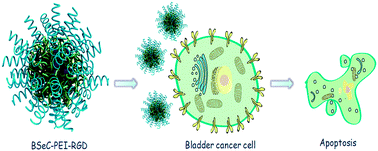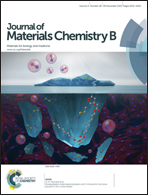An integrin-targeting nanosystem as a carrier of the selenadiazole derivative to induce ROS-mediated apoptosis in bladder cancer cells, from rational design to action mechanisms†
Abstract
The development of novel therapeutics for patients with bladder cancer is an important area of research, particularly considering the rather limited treatment options currently available. In this study, we designed and synthesized a conjugate of cancer-targeting selenadiazole derivative BSeC (benzo[1,2,5]selenadiazole-5-carboxylic acid) and the RGD (arginine–glycine–aspartate) peptide, which was used as a targeting molecule, using a PEI polymer as a linker. The results showed that BSeC–PEI–RGD formed core–shell spherical nanoparticles with improved stability in physiological and low pH solutions. The cancer-targeting design significantly enhanced cellular uptake of BSeC–PEI–RGD and decreased its cytotoxicity to normal cells. The nanoparticles could inhibit the migration and invasion of EJ and T24 bladder cancer cell and reduce cancer cell proliferation through the induction of reactive oxygen species (ROS)-dependent apoptosis and mitochondrial dysfunction. Further mechanistic studies using western blotting showed that BSeC–PEI–RGD triggered bladder cancer cell apoptosis by activating p38, JNK and p53 and by inactivating AKT and ERK. In summary, this study demonstrates the rational design of a polymer-based cancer-targeting nanosystem as a carrier of the selenadiazole derivative to treat bladder cancer.


 Please wait while we load your content...
Please wait while we load your content...